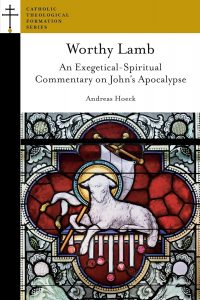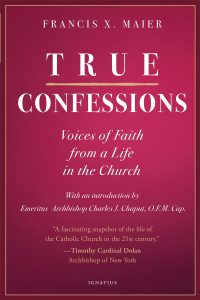Worthy Lamb: An Exegetical-Spiritual Commentary on John’s Apocalypse. By Andreas Hoeck. Reviewed by Fr. Joseph Briody. (skip to review)
True Confessions: Voices of Faith from a Life in the Church. By Francis X. Maier. Reviewed by Fr. Stephen Rocker. (skip to review)
In the Stars the Glory of His Eyes: Tales of an Irish Tour Guide in Rome. By Kieran Troy. Reviewed by Christopher Siuzdak. (skip to review)
Everyday Witness: Seven Simple Habits for Sharing Your Faith. By Sr. Theresa Rickard, O.P. Reviewed by Richard Grebenc. (skip to review)
Worthy Lamb – Andreas Hoeck
Hoeck, Andreas. Worthy Lamb: An Exegetical-Spiritual Commentary on John’s Apocalypse. Saint Paul, MN: Saint Paul Seminary Press, 2024. 542 pages.
Reviewed by Fr. Joseph Briody.
 Saint Jerome’s biblical work led “every reader to the mystery of Jesus, while . . . providing the exegetical and cultural information needed for a correct and fruitful reading of the Scriptures” (Pope Francis, Scripturae Sacrae Affectus). The author of Worthy Lamb does the same. He draws the reader into the mystery of Jesus and offers a profound understanding of the final book of the Bible — a book often misrepresented and sensationalized. The author of Worthy Lamb begins with the words: “Jesus is the first and the last name mentioned in the Book of the Apocalypse.” It is to the Crucified and Risen Jesus we are drawn in Worthy Lamb. Sound exegesis pushes out shallow sensationalism while not underestimating the sufferings of the Church or the misery of the world brought about by the awfulness of sin. John’s Apocalypse consoles, exhorts, and calls to conversion and love. When we bypass these basics, we miss the point. Walking verse by verse through the Apocalypse of Saint John — and looking through his eyes — Worthy Lamb reminds us of what life is about, the meaning of our trials, as well as our dignity and destination.
Saint Jerome’s biblical work led “every reader to the mystery of Jesus, while . . . providing the exegetical and cultural information needed for a correct and fruitful reading of the Scriptures” (Pope Francis, Scripturae Sacrae Affectus). The author of Worthy Lamb does the same. He draws the reader into the mystery of Jesus and offers a profound understanding of the final book of the Bible — a book often misrepresented and sensationalized. The author of Worthy Lamb begins with the words: “Jesus is the first and the last name mentioned in the Book of the Apocalypse.” It is to the Crucified and Risen Jesus we are drawn in Worthy Lamb. Sound exegesis pushes out shallow sensationalism while not underestimating the sufferings of the Church or the misery of the world brought about by the awfulness of sin. John’s Apocalypse consoles, exhorts, and calls to conversion and love. When we bypass these basics, we miss the point. Walking verse by verse through the Apocalypse of Saint John — and looking through his eyes — Worthy Lamb reminds us of what life is about, the meaning of our trials, as well as our dignity and destination.
Worthy Lamb was sent to me by a friend. I expected to dip into various sections, especially those surrounding Revelation 5:6 (“the Lamb standing as if slain”), and then to pay attention to the introduction, conclusion, and some other sections. The problem: the book was too captivating for a cursory glance or speed read. Because of its depth, accessibility, and spiritual attractiveness, I was compelled to slow down, take it section by section, savor passages, and basically relish its biblical and spiritual profundity. This is a commentary worth having on the bookshelf and one to which I will return.
The book builds upon many years of scholarship, a scholarship placed at the service of the reader’s spiritual life and so at the service of Christ’s Church. Father Andreas Hoeck is like a good spiritual director who proposes a biblical passage (here the Book of Revelation) and reads it with us, pointing out aspects we would otherwise have missed, and helping us appreciate and appropriate the Word of God.
Worthy Lamb is a learned but accessible lectio divina, a holy reading of the Book of Revelation, centered on the sufferings and glory of those who live in the Crucified and Risen Jesus — the Lamb “standing as if slain” (Rev 5:6). It is a real gift to biblical theology and spirituality. It could serve as a very fine resource for individual or group Bible study. To study the book as a group over several months would, I believe, bring tremendous enrichment of spiritual and ecclesial life. The last book of the Bible cannot be understood adequately outside of the heart of the Church or apart from the sacred liturgy. The last book of the Bible is the great liturgical book centered on adoration at the throne of God and the Lamb, as the Holy Spirit prompts the Church-Bride to cry out to the Lord Jesus: “Come!”
Worthy Lamb reads like a living patristic commentary and embodies the call of the Second Vatican Council, of Benedict XVI, and of Pope Francis for exegesis to be theology so that Scripture can be the soul of theology. The book illustrates the fulfilment of Old Testament promises and so brings many biblical strands together. Indeed, the importance of the Old Testament as the inspired Word of God becomes clear. There are about one thousand Old Testament innuendos in Revelation and, Hoeck comments, “it is not an exaggeration to say that the Old Testament is sufficient to unlock every single apocalyptic simile” (xii).
Some sections of the book are superb in their depth and richness of insight. The book offers many moments when the reader must simply put it down, pause, pray, and thank God for the wonders of his divine revelation. One such moment is the reflection on the Woman clothed with the sun, the Ark of the New Covenant, in Revelation 12. Here, the various levels of symbolism are drawn together: Mary, the New Eve, the Church, the New Israel, and so on. Mary is “our Sister, Mother, and our Queen.” She is forever “the gateway to Jesus, as well as Christ’s entryway into this world” (190). Mary’s humility will always outmaneuver Satan’s pride (203). The famous one hundred and forty-four thousand redeemed (14:1) “represent the totality of saved humanity, having entirely grown into God’s plan” (238). Again, this is a call to conversion, an invitation to the reader to grow into God’s saving will and plan.
Worthy Lamb has beautiful prose, provides background historical context for the biblical text, gives contemporary application, and reveals spiritual depth. Fr. Hoeck takes a unique approach. He brings learning and humility to the inspired text. He also views it through the lens of Rupert of Deutz (d. 1129) and Adrienne von Speyr (d. 1967): their insights are referenced throughout the book.
Practically, the biblical text of each small section is given before Hoeck’s commentary on that section. This helps the reader and frees from the need to have a Bible at hand. The translation provided is the NRSVCE, but Hoeck notes important points along the way, offers his own translation at times, and often refers to the Nova Vulgata. He refers continually to the original Greek and comments on relevant Hebraisms. Fr. Hoeck offers insightful and life-giving commentary so that the reader is personally challenged and strengthened.
The counterfeit nature of evil is brought out well in Worthy Lamb. The dragon can only ape the Lamb’s work of redemption: it, too, has a wound that was healed over. The mere imitation, envy, and mimicry on the part of the dragon is clear: “no scar remains in the beast, while the marks of our Lord’s wounds visibly perdure (Jn 20:27)” (219). This raises a good question: how can we tell the false from the authentic? “[T]he Lamb and his followers conquer, not by slaying but by dying” (221). Or again, “Christ sheds his own blood, while the antichrist sheds the blood of others” (229). Hoeck moves us away from sensationalism and any unhealthy or alarmist apocalypticism, moving us rather to encounter the Risen-Crucified One who calls to conversion, to hope, to witness, and to love. Worthy Lamb moves us to offer ourselves more with Christ, living his sacrificial love. Instead of fomenting terror or alarm, the relational urgency of conversion, fidelity, and witness comes across.
This book is best read reflectively and over time. The author’s erudition shines through. There is a sprinkling of some less common words (e.g., homodiegetic, analepsis, exergasia, cacotopia, gematria, isopsephy, dysphemism, and metalepsis). However, these in no way take away from the predominant and enduring sense of the reader’s satisfaction. The reader’s sense is of nourishment, ease, edification, and even spiritual awakening. Holiness, virtue, hope, and trust are communicated to the receptive reader. All things are in God’s hands and permitted by him and “God gives us sufficient time to do good and to complete our Christian witness in this life” (171). Surrender to the Lord, working for him, and patiently awaiting him are important for the believer. Our holiness lived today, gives glory to God forever (472).
Saint John’s Apocalypse brings us through the entire Bible. It ends where the Bible begins, in Eden, but now with the new creation, a New Eve, a New Jerusalem. Hoeck comments beautifully on these last things: “to dwell in heaven means to possess everything for which humanity yearned.” Before the throne of God and the Lamb, “humanity has arrived at the end of its historical adventure, it has finally come home and is at rest” (455). Seeing God face to face and having his image perfected in us is “the culmination point of biblical spirituality.” It is “to serve, to see, and to resemble the Lord God” (457). As we pray at Mass: “Blessed are those called to the supper of the Lamb!” (Rev 19:9).
This is an excellent read. For anyone willing to read seriously, reflect, pray, and be transformed by the Word of God, especially the Bible’s last book, this is a treasure. It may even become a classic. It should!
Fr. Joseph Briody, S.T.D., is a priest of the Diocese of Raphoe (Donegal, Ireland). He is Professor of Sacred Scripture and Director of Spiritual Formation at Saint John’s Seminary, Brighton MA.
True Confessions – Francis X. Maier
Maier, Francis X. True Confessions: Voices of Faith from a Life in the Church. San Francisco, CA: Ignatius Press, 2024. 284 pages.
Reviewed by Fr. Stephen Rocker.
Francis X. Maier, longtime worker in and commentator on Catholic Church life, has given us substantive comments from people deeply involved in Catholic life. All those interviewed who offer their appraisals and suggestions about the condition of the Church, especially in America, fall into the middle-right segment of the political/ecclesial spectrum. Retired Archbishop Charles Chaput has a large presence in the book through a lengthy interview, his preface, and statements from people who have worked for and been influenced by the archbishop, including Maier himself. The diocesan bishops and a few others who are interviewed are not named; otherwise those interviewed are identified.
To this reviewer, the most informative and engaging interviews are with diocesan bishops and a few others to be mentioned. From the bishops’ interviews, any reader should come away with a deeper sense of the challenge a bishop has in holding together the various elements of the Church in the midst of mostly numeric decline in people, practice, and institutions of Catholic life. One bishop notes, “Most of our people are effectively Protestants.” Another notes that the loss of natural law thinking has diminished the Church’s authority and people’s ability to recognize right and wrong. On President Biden’s Catholicism, his rosary beads have evidently created conversation among bishops, as one bishop comments that Biden’s rosary “is a bit like a perfume bottle. It’s empty, but you can still catch the scent of the perfume now and again.” Another comments that “Joe Biden’s faith stops at the rosary beads in his pocket.” On Pope Francis, one bishop comments he “fosters ambiguity”; and in various forms, that appraisal of Pope Francis surfaces in many interviews.
This reader found fascinating the interview with a friend and associate of former Cardinal Archbishop Lustiger of Paris, who had converted from Judaism. Another engaging and inspiring interview was with a Peruvian native and member of a consecrated lay society whose founder and vicar general were later involved in sexual scandal. Despite this scandal, he expresses the faith as a challenging adventure that creates a context for personal conversion and notes the fear of having children is killing the Church in the developed world. In his interview, Fr. Joseph Fessio, student of de Lubac, von Balthasar, and Ratzinger, gives a punchy history as a Jesuit from the 1960s to the present.
Readers also hear from large donors to Church programs and institutions, immigrants, parents of children with special needs, and those who work professionally for the Church.
When giving suggestions about how to advance the Church’s work, some of the suggestions can seem easily made without having to develop more concretely and practically the suggested changes. For example, a goodly number of the interviewees call for bringing people to Christ rather than maintaining present buildings, schools, and programs. Such talk seems airy without specific development, since bringing souls to Christ at all in the Catholic faith is largely done by the churches, schools, and programs we have. On a factual matter, Maier and the president of the Tepeyac Leadership Initiative take it that President Trump has revealed or brought to the surface a political toxicity that has been present in American society. This reviewer would argue that Trump has not only revealed but has significantly grown and nourished that toxicity.
More than one of the lay people interviewed are angry that Church leaders were lacking courage in complying with government restriction during the pandemic. It seems to this reviewer the Church’s moral teaching required cooperation in responding to this health threat. There are worrying signs in our society of opposition to and suppression of the Church and the exercise of her teachings, but the pandemic response is not a clear instance of that opposition.
Whatever differences a reader may have with Maier’s or interviewees’ statements, one is inspired by their engaged dedication to the Church and stimulated by their insights on its challenges.
Rev. Stephen Rocker is a priest of the Diocese of Ogdensburg (New York).
In the Stars the Glory of His Eyes – Kieran Troy
Troy, Kieran. In the Stars the Glory of His Eyes: Tales of an Irish Tour Guide in Rome. San Francisco, CA: Ignatius Press, 2022. 267 pages.
Reviewed by Christopher Siuzdak.
 This work can be described best as an experienced tour guide’s collection of favorite trips and most memorable travels around the European continent, primarily Rome, but it also highlights the wisdom, humor, and joy of religious pilgrimages and the Catholic faith in general.
This work can be described best as an experienced tour guide’s collection of favorite trips and most memorable travels around the European continent, primarily Rome, but it also highlights the wisdom, humor, and joy of religious pilgrimages and the Catholic faith in general.
The title of the book is derived from a poem by the Irish republican, poet, and journalist Joseph Mary Plunkett (1887–1916), who describes seeing God in everyday things everywhere: every flower, sea, thunder, and rain, rocks his written words, every tree his cross, “and in the stars the glory of his eyes.”
Reminiscent of the countless number of stars in the sky, Troy brings attention to the small miracles and evidence of God’s providence through everyday aspects, which he describes as “little surprises” (43) and “the good Lord at work all around” (103) during his more than quarter century of operating a travel agency together with his wife.
The prologue, a short introduction into a day in Troy’s life as a tour guide, tells the story of his worrying whether there will be enough attendees at a schoolgirls’ choir concert he helped organize, and then the trepidation about whether there will be enough wine and cheese to feed the large audience that unexpectedly gathered. Like the miracle of Jesus turning water into wine at the wedding feast at Cana, the story depicts Troy as a tour guide who goes above and beyond to work small miracles for his tour attendees. Through prayer, ingenuity, quick thinking, a bit of risk-taking, and trust in the goodness of others, Troy is able to work small miracles to ensure his customers have a positive traveling experience. He calls himself a “fixer,” rather than a guide or courier, because he is in “a business of solving problems” (213). Troy mentions his actions as an everyday call to sainthood: “We pray with words . . . but we also pray with our actions” (185).
Near the end of the book, Troy humbly describes his work as a tour guide as someone who is not a great public speaker, someone whose commentary was once described by a demanding client as “a mouse squeaking into the microphone” (223). He tells a story of how pilgrims have tears in their eyes comparing panels of the sacrifice of Isaac by Abraham and Jesus carrying the cross by Alessandro Algardi in St. John Lateran Basilica in Rome: “There is something in these biblical works of art that touches people’s hearts, transcending the deficiencies of any guide” (223). Troy’s book falls into that same transcending category.
Stories in the book are heart-touching as in the tale of a trip taken in memory of beloved traveler Father Sean Higgins. Higgins’ death from cancer prohibited him from attending a trip carefully planned for family and friends, yet “every last one of them” decided to continue on the trip in his honor (34). During the trip, multiple “small miracles” occurred: being able to schedule last-minute flights on the feast day of St. Maria Goretti after an Alitalia airline workers’ strike and then being aboard an Aer Lingus plane named “Saint Oliver Plunkett.” Both saints were among Father Higgins’ favorites.
At times, the book’s stories have a tongue-in-cheek humor, such as when Troy is sheepishly caught holding up a line turning dozens of rosaries into third-class Padre Pio relics by touching them to the saint’s tomb as a favor to a friend, or when he celebrated finding the dilapidated chapel of Irish Monsignor Hugh O’Flaherty with tea and biscuits with his tour group in front of a nay-sayer, dour-faced golf club official.
Stories in the book can also give you goosebumps: how a bullet from an 1981 assassination attempt zigzagged through St. Pope John Paul II’s body to narrowly miss all his major vital organs (252), how the Veil of Manoppello’s image of Jesus could only be produced by “a burst of incredibly powerful ultraviolet light” (166), and how Pope Francis touched the hand of a traveler, who “felt that she was once again in the presence of” her deceased son (102), even though the group did not have well-positioned tickets to the papal audience that day. Troy had a knack for succeeding in situations where the odds were not in his favor.
There are also educational aspects of the book, which make it a catechetical learning tool for non-Catholics and Catholics alike. Topics include veneration of relics (190), transubstantiation (201), Mary’s immaculate conception (121), the canonization of saints, the Petrine Office and papal succession, the apparitions of Mary in Fátima (Portugal) and in Lourdes (France). Historical topics covered and explained in the book include the Holy House of Loreto, a shrine which is believed to hold Mary’s relocated Nazareth home, the Battle of Vienna in 1683 between Poland’s King Jan Sobieski III and the Ottoman Empire, the painting of the Sistine Chapel by Michelangelo, and World War II.
It would be helpful for a reader to have some familiarity with Catholicism and some background knowledge of history and travel destinations. Readers unfamiliar with geography of tourist attractions might not know that the Spanish Steps are in Rome, for instance. The book would have benefitted from the inclusion of photographs or maps, which could clarify historic sites that Troy mentions and could help readers better visualize the scene described by the author. Having Irish heritage or interest in Irish saints or sites can also aid in understanding some of the book’s stories. Most of Troy’s trips involve Irish travelers or points of interest for those with an affinity for the history and culture of Ireland. For example, the tomb of the Irish-born missionary Saint Columban in Bobbio (Italy) might be otherwise overlooked but features prominently in Troy’s map of the world and his travel itinerary.
What sets Troy’s book apart is that it is told as if we, the readers, are on a coach bus traveling along for an adventure. He tells the stories of people and places with history, humor, and heart, all in small bite-sized, easy-to-read chapters. Each chapter’s ending flows into the beginning theme of the next chapter, but stories can be read individually or cohesively, similar to a “Chicken Soup for the Soul” book. Troy is an engaging and intelligent story-teller, and undoubtedly a wonderful tour guide. He ends the book as he would a tour, thanking us for traveling together with him, with the hope of seeing him again on a future journey.
Although this book is not a standard guidebook in terms of comprehensive historical and artistic facts of select sites frequented by visitors, it is recommended for people planning a pilgrimage to Rome or other European sacred sites because several points of interests mentioned in the book might pique their interest and be adopted into their itinerary. The experiences recounted in this work will also help form the best attitudinal disposition for those embarking on a pilgrimage. Those who have already been on pilgrimage will have an opportunity to reminisce and relish their own experiences by reading this text. For those unable to travel due to whatever limitations, the author’s gripping prose will give them a real sense of being escorted on a journey. The book’s last page leaves the reader with the understanding that both Troy’s and God’s trips and tales are ongoing. Like the infinite stars in the night sky, “it is really the providence of God that has been prevailing all along,” (238), and it is our open-ended quest to follow along, if we so choose.
Christopher Siuzdak is book review editor for the Homiletic & Pastoral Review.
Everyday Witness – Sr. Theresa Rickard, O.P.
Rickard, Sr. Theresa, O.P. Everyday Witness: Seven Simple Habits for Sharing Your Faith. Notre Dame, IN: Ave Maria Press, 2019. 128 pages.
Reviewed by Richard Grebenc.
 In teaching high schoolers, the idea of witnessing to one’s faith daily in practical ways is a consistent theme in my lessons. Thus, Sr. Terry Rickard’s short volume, Everyday Witness: 7 Simple Habits for Sharing Your Faith, stood out to me as a potentially helpful guide to convey, in basic terms, how discipleship can be effected in the contemporary world.
In teaching high schoolers, the idea of witnessing to one’s faith daily in practical ways is a consistent theme in my lessons. Thus, Sr. Terry Rickard’s short volume, Everyday Witness: 7 Simple Habits for Sharing Your Faith, stood out to me as a potentially helpful guide to convey, in basic terms, how discipleship can be effected in the contemporary world.
It is always instructive to know the author’s goal in writing the book. In the Introduction, she expands on what is already stated in the book’s subtitle: “I hope the seven simple and easy-to-adapt habits shared here will help you grow comfortable in giving authentic life-changing witness to your faith . . . My hope is that this book becomes a tool for spiritual growth and practical skill development in the Christian task of spreading the Good News of our salvation in Christ Jesus” (xiv). The seven chapters that follow explicate these habits: Choose Joy, Be Humble, Preach from the Pulpit of Life, Pray Unceasingly, Listen with a Cupped Ear, Practice the Art of Accompaniment, and Engage in God-Talk.
It is quite clear from this list that Pope Francis is a great inspiration to Sr. Terry. In particular, she looks to his 2013 apostolic exhortation, The Joy of the Gospel, as a guide for the Christian to provide the “everyday witness” that is the title of this book.
Each chapter is divided into several helpful sections. Beginning with prayer, always from Scripture, usually from the Psalms, she follows with a section that provides a basic catechesis on the particular habit along with a personal story and/or historical example of the habit in action. Then it is back to the Bible with a pithy passage that witnesses the habit’s roots in Holy Writ. Here, the author brings in additional scriptural warrant for the particular habit as well as more personal stories that show the habit working in real-life situations, some of which are particularly heartwarming (and sometimes heartrending). Next, a focus on a particularly moving witness that Sr. Terry has experienced directly through others is given its own section. Each chapter then wraps up with: “Prompts for Self-Reflection” which contains two or three questions for the reader to ponder regarding the habit in question along with space to answer; “Growing the Habit” which encourages prayer for the gift of the habit, awareness of the gift in your life, an intention on how you have experienced it or might use it, and, finally, an encouragement to use it in your everyday witness; lastly, a prayer, composed by the author, reminding the reader of what he has just read and asking the Lord to help him implement it in his life.
A short appendix gives practical tips for personal witness as well as encouraging others to witness in your parish community, the latter of which I found particularly helpful.
I like books that are divided into short sections, particularly those that are meant to bring the spiritual life into the practical realm. The reader can easily polish off a chapter a day in a half-hour, including contemplating and considering the answers to the “Prompts for Self-Reflection.” Or a person could work on implementing one habit each week, going over portions of the chapter, observing others, and working the habit into his own actions.
Being a short work, it is not intimidating even for the person who does not consider himself a “reader.” Certainly good for personal use, I think it would be particularly effective in a small group setting as it would give the attendees an opportunity to share ideas and insights along with actually fulfilling, practically, the title, Everyday Witness. And it can be returned to regularly to gauge progress, remind one of other facets of the habit, glean new insights, and consider the various habits in light of personal growth and new experiences.
This makes an excellent gift for oneself, or for the person of faith who struggles with how to fulfill the call to witness to his faith. For those who might be intimidated or uneasy about “talking the talk,” this relatively brief work focuses on “walking the walk” — without precluding the possibility of sharing the faith explicitly (see especially the seventh chapter).
And, yes, I will be sharing (and hopefully living out) these habits with my high schoolers.
Richard Grebenc is a theology teacher. He resides in South Florida.


Recent Comments